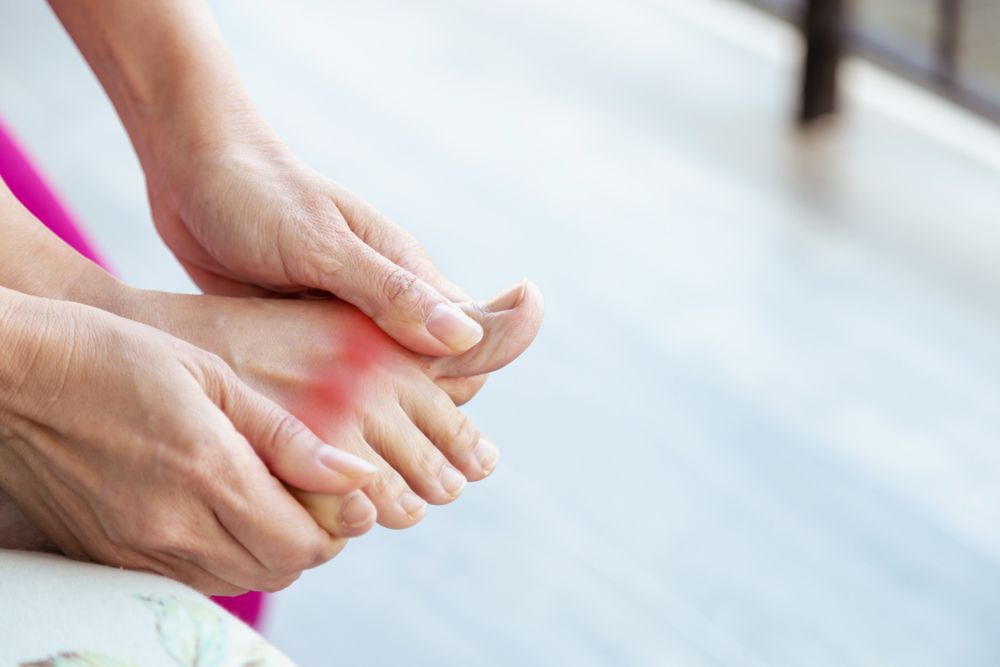Gout / Pseudogout
These diseases are characterized by acute or chronic arthritis due to deposits of crystals in the joints and surrounding structures (tendons, ligaments, soft tissues, etc.). Gout, which has both an acute and chronic form, is characterized by the deposition of monosodium urate crystals. The deposition of calcium pyrophosphate crystals leads to calcium pyrophosphate deposition disease (CPPD), also known as pseudogout. These conditions are among the most common causes of inflammatory arthritis. Identification of crystals in joint fluid is the often the key to the correct diagnosis.
Gout
Gout is a disease caused by too much uric acid in your body that can be deposited in various sites, including joints. Too much uric acid may not cause symptoms for years. But over time, the accumulation of deposits may cause painful joint inflammation (arthritis). There is also a growing body of literature that shows that high levels of uric acid increase your future risk of cardiovascular disease (e.g. heart attacks, strokes), as well as worsening chronic kidney disease.
Gout most commonly affects middle-aged men, but it can occur at any age. Only 5 to 10% of cases of gout occur in women, usually after menopause.
The pain of an acute gout attack is often extreme, especially in the first few episodes. The initial episodes frequently involve a single joint, commonly the big toe. However, any joint can be affected. Episodes typically last from 7-14 days at a time. This can interrupt sleep, prevent walking, and interfere with work and leisure. With the passage of time, recurrent acute arthritis may involve multiple sites, including the ankles, knees, and the joints in the upper extremities.
When recurrent acute gout goes untreated over a long period of time, and when there is a failure to eradicate causative factors, the condition may evolve. The patient may progress from having sporadic arthritis attacks of only one joint to having repeated attacks in multiple joints with increasing frequency; this can even progress to persistent low-grade joint inflammation and irreversible joint deformities. Over time, uric acid crystals can deposit into the skin and appear as visible lumps, also known as tophi. Swelling and deformity then become the characteristic signs, but without the intense inflammation.
Your physician may deem it necessary to aspirate fluid from an inflamed joint to demonstrate that the uric acid crystals are the cause of the joint pain & inflammation. Also, blood and/or urine tests may be indicated to assess the degree of increased uric acid in your body, as well as to rule out other causes of arthritis. X-rays of the affected joints may additionally be necessary to determine if joint or soft tissue damage has occurred. In certain instances, a special type of CT scan, called a dual-energy CT scan, can be used to look for uric acid deposits in joints & soft tissues.
The principle goal of treatment includes treating the acute attacks early and effectively, which often includes the use of medications. It is also important to correct factors that may contribute to increased uric acid levels. These include decreasing excessive alcohol use, correcting obesity or decreasing the use of medications (if possible) that can increase uric acid levels in the body. Also, ingestion of foods high in purines (precursors of uric acid), such as red meat, wine and beer need to be decreased. Excessive consumption of high fructose corn syrup can also be a trigger for gout flares. Finally, medications to decrease the uric acid pool in the body can be instituted.
Medications Used for the Treatment of Gout
Acute Flares
The most commonly used medications to treat an acute gout flare include steroids (such as prednisone) and non-steroidal anti-inflammatory drugs (such as ibuprofen and naproxen). These medications help to decrease the intense inflammation associated with acute gout.
Another medication commonly used for the treatment of an acute gout flare is called colchicine. This medication works best when started within the first 24-48 hours after symptoms begin.
Chronic Gout
When the uric acid level is too high and gout flares keep occurring, additional medication is often needed to decrease the uric acid level and minimize future flares. This is known as urate-lowering therapy. The most used medication for this purpose is called allopurinol.
Allopurinol works by blocking the action of an enzyme called xanthine oxidase. DNA in our bodies is eventually broken down into molecules called purines. When these purines (along with that found in purine-rich foods mentioned above) are broken down further, the end-product is uric acid. Allopurinol, as well as a similar medication called febuxostat, helps prevent this breakdown process so that less uric acid is produced.
Although quite rare, certain people have an increased risk of a severe reaction to allopurinol. In these patients, it is often recommended to screen for this increased genetic risk prior to starting allopurinol.
When the uric acid level does not decrease to acceptable levels with just urate-lowering therapy, or if there are large uric acid deposits in the body (known as tophi), another medication may be used called pegloticase (Krystexxa). This medication is very effective in breaking down uric acid so that it can be excreted from the body. It is administered as an intravenous infusion every 2 weeks. Over time, it is common for pegloticase to become less effective, so it is often given together with another medication to maintain its efficacy for as long as possible.
CPPD & Pseudogout
Calcium pyrophosphate deposition disease (CPPD), also known as pseudogout, is a chronic condition that results from the local overproduction of pyrophosphate in cartilage which causes the deposition of calcium pyrophosphate crystals in the joints and surrounding tissues. CPPD is a disease of aging. The prevalence of findings of calcium pyrophosphate deposition on x-rays (called chondrocalcinosis) is 10% of the population between 60 and 75 years and 30% or more of the population 80 years and older. It is not known why the body forms these crystals but there may be an abnormality in the cartilage cells or connective tissue. The cause also may be due to a genetic tendency. Certain conditions, such as hyperparathyroidism and hemochromatosis, can be associated with the development of CPPD.
Episodes of acute pseudogout occur when CPPD crystals are shed from the cartilage. This can occur after surgery, from direct trauma to the joint, or from joint inflammation. It usually appears as the sudden onset of swelling, warmth, and pain in one joint, typically the knee (in 50% of attacks), wrist, or ankle. The degree of inflammation may be less than that seen in gout. Multiple joints may be affected, and the condition may be accompanied by fever. Joint inflammation peaks on day 2 or 3 and can last from 7 to 14 days with subsequent resolution.
Similar to gout, a chronic form of CPPD arthritis can develop with pain and deformity. This usually develops in the knees, but any joint can be affected.
It may be necessary to aspirate fluid from the inflamed joint to identify crystals to make the appropriate diagnosis. Also, standard x-rays can show chondrocalcinosis, especially in the wrist and knee.
Episodes of acute pseudogout are treated in a similar manner as acute gout. Aspiration of the affected joint often provides relief, and additional medications are often needed to treat the pain and inflammation. Chronic arthritis is treated symptomatically with medicines to decrease the inflammatory response, as well as medicines to decrease the levels of uric acid in the body




